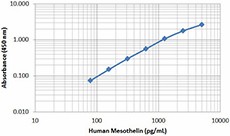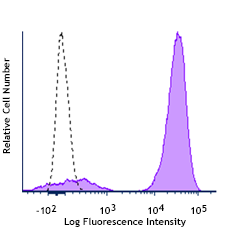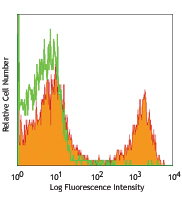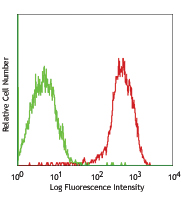- Clone
- MB (See other available formats)
- Regulatory Status
- RUO
- Other Names
- MSLN, CAK1
- Isotype
- Mouse IgG2a, κ
- Ave. Rating
- Submit a Review
- Product Citations
- publications

| Cat # | Size | Price | Quantity Check Availability | Save | ||
|---|---|---|---|---|---|---|
| 530203 | 50 µg | £150 | ||||
Human mesothelin, also known as CAK1 and MSLN, is a cell-surface protein6 expressed on normal mesothelial cells lining the pleura, pericardium, and peritoneum. It is expressed as a 70 kD pre-cursor protein with a furin cleavage site, which produces two products: 1) megakaryocyte potentiating factor (MPF) (30 kD) and 2) mesothelin (40 kD). MPF is a cytokine that is released. Mesothelin, for the most part, is membrane-bound by a glycosylphosphatidylinositol linkage and has three glycosylation sites. Soluble mesothelin is believed to result from proteolytic cleavage to release it from the membrane linkage, or from alternative splicing of the mesothelin gene.
The normal function of mesothelin is not known. Mice knockouts produced no obvious phenotypes with normal growth and reproductive parameters. However, mesothelin is overexpressed by cancer cells, particularly in mesotheliomas, ovarian adenocarcinomas, pancreatic adenocarcinomas, and squamous cell carcinomas, and lung cancers. It binds to MUC16/CA-125, which is a cell surface mucin and ovarian cancer biomarker, and has been speculated to be involved in peritoneal dissemination of ovarian cancer cells. Mesothelin has also been shown to be elevated in the serum of cancer patients compared to normal patients. As such, it has become the focus of cancer research in the areas of diagnostics, immunotherapy, and cancer vaccinology. For example, SS1P is a recombinant immunotoxin which targets mesothelin-expressing cancer cells. Its anti-mesothelin Fγ domain confers specificity, while its Pseudomonas exotoxin domain results in cell death. This potential drug has already finished Stage I clinical trials.
Product Details
- Verified Reactivity
- Human
- Antibody Type
- Monoclonal
- Host Species
- Mouse
- Immunogen
- DNA immunization (mesothelin expression plasmid) with mesothelin-Fc fusion protein for final boost.
- Formulation
- Phosphate-buffered solution, pH 7.2, containing 0.09% sodium azide.
- Preparation
- The antibody was purified by affinity chromatography and conjugated with biotin under optimal conditions.
- Concentration
- 0.5 mg/ml
- Storage & Handling
- The antibody solution should be stored undiluted between 2°C and 8°C. Do not freeze.
- Application
-
ELISA Detection - Quality tested
ELISA Capture, FC, IHC-P, WB - Reported in the literature, not verified in house - Recommended Usage
-
Each lot of this antibody is quality control tested by ELISA assay. A concentration of 0.5 µg/ml of the detection antibody was utilized to generate the example standard curve for human mesothelin. It is recommended that each lot of reagent be titrated for optimal performance for each application.
- Application Notes
-
ELISA Detection: To measure human mesothelin, this antibody can be used as a detection antibody in sandwich ELISA format, and paired with the purified (clone MN) antibody (Cat. No. 530101) as the capture antibody. Recombinant Human Mesothelin (ELISA Std.) (Cat. No. 593209) can be used as the protein standard.
Note: For testing human mesothelin in serum, plasma, or supernatant, LEGEND MAX™ Human Mesothelin ELISA Kit (Cat. No. 438607 & 438608) is specially developed and recommended.
-
Application References
(PubMed link indicates BioLegend citation) -
- Onda M, et al. 2005. Clin. Cancer Res. 11:5840.
- Product Citations
-
- RRID
-
AB_2571909 (BioLegend Cat. No. 530203)
Antigen Details
- Structure
- ~40 kD glycoprotein that can be membrane-bound, or released from the membrane in a soluble form.
- Distribution
-
Mesothelial cells lining the pleura, peritoneum, and pericardium. It is also located in various cancer cells.
- Function
- Not known. May promote carcinogenesis and metastasis.
- Interaction
- Various cancer cells such as ovarian and pancreatic cancer cells.
- Ligand/Receptor
- CA125 (MUC16).
- Biology Area
- Cancer Biomarkers, Cell Adhesion, Cell Biology
- Molecular Family
- Cytokines/Chemokines
- Antigen References
-
1. Pastan I, et al. 2014. Cancer Res. 74:2907.
2. Hellstrom I, et al. 2011. Expert Opin. Med. Diagn. 1:227.
3. Hassan R, et al. 2008. Eur. J. Cancer 44:46.
4. Hassan R, et al. 2006. Clin. Cancer Res. 2:447.
5. Onda M, et al. 2005. Clin. Cancer Res. 16:5840-6.
6. Hassan R, et al. 2004. Clin. Cancer Res. 10:3937.
7. Scholler N, et al. 1999. Proc. Natl. Acad. Sci. 96:11531. - Gene ID
- 10232 View all products for this Gene ID
- UniProt
- View information about Mesothelin on UniProt.org
Related Pages & Pathways
Pages
Related FAQs
- How many biotin molecules are per antibody structure?
- We don't routinely measure the number of biotins with our antibody products but the number of biotin molecules range from 3-6 molecules per antibody.
Other Formats
View All Mesothelin Reagents Request Custom Conjugation| Description | Clone | Applications |
|---|---|---|
| Biotin anti-human Mesothelin | MB | ELISA Detection,ELISA Capture,FC,IHC-P,WB |
Customers Also Purchased
Compare Data Across All Formats
This data display is provided for general comparisons between formats.
Your actual data may vary due to variations in samples, target cells, instruments and their settings, staining conditions, and other factors.
If you need assistance with selecting the best format contact our expert technical support team.
 Login / Register
Login / Register 

















Follow Us